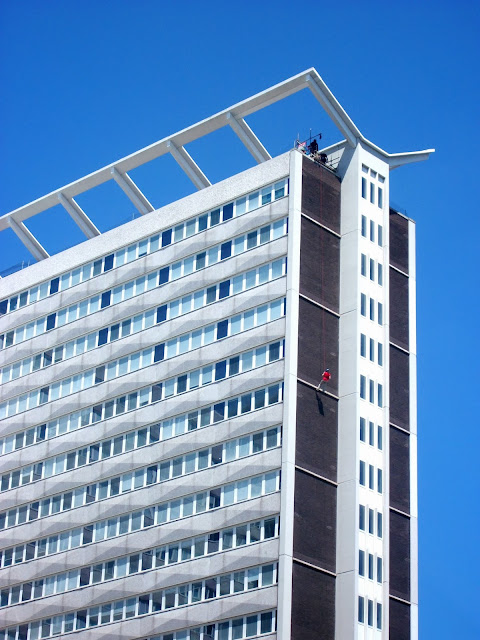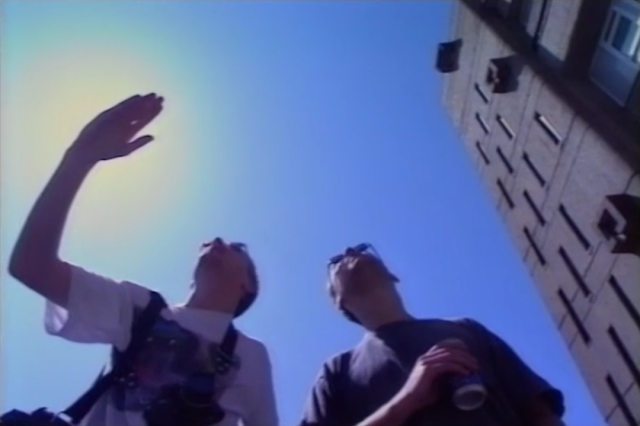How We Used to Live
I am a fan of Saint Etienne. I am a postwar history obsessive. I love the Barbican. So the screening of Saint Etienne's archive film How We Used To Live at the Barbican last night was pretty much my idea of a perfect night out.
This archive collage film directed by Paul Kelly was inspired by Terence Davies' hymn to Liverpool, Of Time and the City. But Saint Etienne and Kelly already have their own style – a kind of melancholy nostalgia for the recent past, from defunct musical genres to lost urban landscapes. And here they have pulled together huge amounts of archive film – some of which was familiar to me, much of which was not – and created a compelling, beautiful and moving portrait of postwar London.
With so much diverse footage, there are three principal things that hold the film together. Firstly the clips have been arranged into an overarching thematic story, from daybreak to sunset, work to home, youth subcultures to a running joke at the expense of the Royal Family. Secondly, to emphasise the narrative there is the lightest of narration from Ian McShane, written by Bob Stanley and Travis Elborough – speech that is as impressionistic as the samples from old film and TV that punctuate St Etienne's album So Tough, for example. And finally - and perhaps most impressively - there is Pete Wiggs' score, an epic soundtrack every bit as moving, warm and evocative as the film footage.
They played the score live last night at the Barbican. I have only seen this done twice before. Once was when Saint Etienne performed their soundtrack to their film (again with Paul Kelly) about the Festival of Britain, This Is Tomorrow, at the Festival Hall. The other time was when Philip Glass performed Koyaanisqatsi at the Barbican alongside a screening of the 1982 film. I found that a magical, immersive, emotional experience, and that's how I found How We Used To Live too. If you get a chance to see the film at a screening, go – if you like the old films I post on this blog, you won't regret it.
___
Update: 14th December 2014: How We Used To Live – Soundtrack by Pete Wiggs
So, I saw the film, with the soundtrack performed live, at the Barbican back in September. Now Pete Wiggs' soundtrack has been released seperately. But how does it hold up without those beautiful visuals?
The best tribute I can pay it is that it works brilliantly as a suite of music in its own right. In a band like Saint Etienne it can be hard from the outside to work out who does what. But from this release it's clear that Pete Wiggs is a hugely talented composer, and deserves plaudits for his work here, which is full of light and shade, whimsy and drama, as well as that sense of melancholy that we have come to expect from his band.
The soundrtrack features lovely snatches of dialogue, in true Saint Etienne style – in this instance taken from Ian McShane's narration, and some from the film clips 'sampled' in the documentary. The commentry from Mickie Most's training run (which introduces the only non-Wiggs track on the album, 'Ready or Not', taken from Sarah Cracknell's solo album Lipslide) is an obvious absurd highlight. These glimpses of dialogue and action help form a framework within the album, holding the tracks together and providing context for the music.
Not that the music really needs the framework, other than to add atmosphere. And not even for that, really, because there's something so evocative of time and place in the tracks. For example, the synth-strings and piano of 'An Old Friend of Mine' paints the sad romance of brief encounters among the grime of old London, echoed later in the even more haunting 'Dawn Strings'. This is something Saint Etienne were always brilliant at – creating a sense of instant nostalgia for something you instinctively feel, but can't quite put your finger on. Their song 'Avenue', for example, is all about visiting memory lanes. It begins with the ghost of a harpsichord, which is soon forgotten in the whispy drama of the song, so that when it blares out again full pelt mid-song the harpsichord gives you shivers, as you respond to something you only half-remember, something they have actually created within the time span of the music. And so, in this soundtrack, Pete Wiggs takes this idea for a walk. Most notably this is in what we might think of as 'Theme from How We Used to Live', but which he calls, 'Where to Begin? Here' (the first track), and its echo, the final track, 'The Paths of Others'. The simple plucked string theme, joined by an angsty spiral of synths, and a sonorous piano riff creates a genuinely spine-tingling reaction when it crops up again (and again). It is a beautiful sound, something sad and majestic, with the feel of Bowie's Berlin instrumentals, those pieces so precise at evoking a city and a time.
Walking around London listening to this album I have begun to see ghosts everywhere: alleyways and side streets I have never noticed before; stained old pubs ignored by regeneration; the time-ravaged undersides of bridges. It is perfect walking music. With imagery from the film still swirling in my junkyard of a brain, it brings to life the pre-Thatcher spirit of London, of head-scarves, market porters, soot-blackened facades and Routemaster buses. Let's hope Pete Wiggs continues to create more music of place and time.
Saint Etienne presents How We Used To Live – original film soundtrack by Pete Wiggs is out now.











Comments
Post a Comment